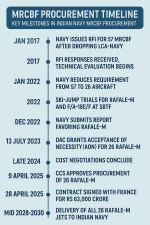I have the impression that the only disadvantage of doing “governments to governments” is that it's never enough to set up an assembly line in India (you need at least 100), but with the 26 we're setting up a fuselage production line, so maybe we'll go step by step with each batch they order, in which case the chances of the 40 have increased a lot.
As a result, the chances of going G2G fast have increased considerably: by gradually installing industrial capacity, India avoids wasting time and does not abandon its objective of industrial sovereignty. The manufacture of fuselages for the 26 Marines paves the way, making the G2G contract for 40 IAF more attractive and more likely than before.
- 26 Marine => you start partial production.
- +40 IAF (without tender) => you complete the local workload.
- + maybe 74 remaining (to reach 114) later in two steps => you would then have enough to economically justify a full FAL.
The ToT for these stopgap deals seems to be left for the OEMs to decide, whereas MRFA will see some negotiations.
These stopgap deals are independent from MRFA. The govt and IAF need MRFA for more than just a fighter jet, there are other political implications involved.
Maybe a potential war with Pakistan could kill MRFA in favor of more Rafales, or we could buy more Rafales and launch MRFA simultaneously to make up for some heavy losses expected.
So it's possible that the elimination of 100-150 jets over the next 2 months over Pakistan could see us buying Rafale in numbers, and MRFA will be launched for a non-Rafale jet, or something else will replace MRFA but with similar impact. It's become quite unpredictable now.


